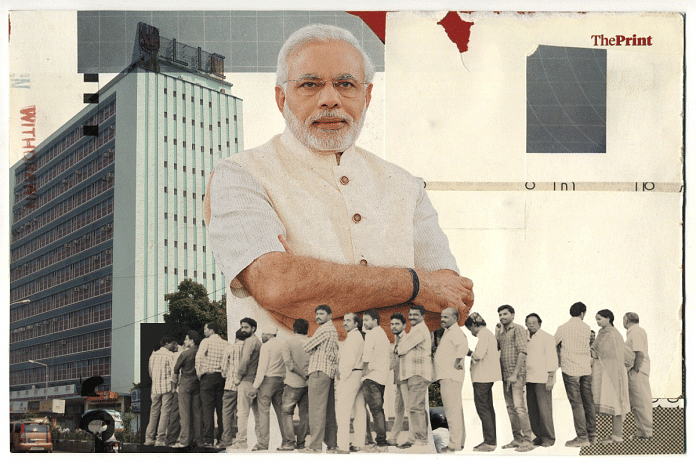LIC, a fully state-owned insurance company, has actively participated in the disinvestment exercise of the government to rescue its struggling public sector companies.
The government and the LIC top brass maintain that decisions to pick up stake in these companies are market and business driven. However, critics have questioned the move on the ground that the money with the LIC belongs to the policy holders and not the government.
The Print asks: Is Modi govt being reasonable or reckless in using LIC to back its ailing public sector?
LIC move could turn out to be a bold investment that pays off handsomely
 Ajit Ranade
Ajit Ranade
Senior fellow, Takshashila Institution
It is obvious that the IBDI is stuck with bad loans. This may have happened because of a business cycle downturn, or for other reasons. The bank needs equity infusion to be able to resume normal business. The government is unable to directly fund equity, perhaps, due to fiscal constraints. Hence, it has asked the LIC to step in and look at an investment opportunity.
Currently, the actual valuation is not known. Every stock is worth it at some cost, especially if it is low enough. When Satyam was going through immense turmoil and its stock had hit rock bottom in the wake of a scandal, Mahindra made a bold decision and bought its shares. It was risky but paid off handsomely.
LIC is an insurance company and can benefit from the synergy with bancassurance and distribution strength of a commercial bank. Most other insurance companies have tie-up with banks.
We can also give the LIC the benefit of doubt for having made a bold investment decision that may pay off. The LIC has a large corpus and routinely has to make quick investment decisions to deploy its funds. Some involve high-risk high reward and some are low-risk low reward. This assessment can only be made by investment experts, and much of the wisdom is post facto.
It is true that the corpus belongs to policy holders and not to the government. But the LIC makes such decisions on a regular basis. The outlook and promise of the IDBI shares has to be considered, when one assesses whether this investment is good or not. In any case, a lot of details are still not known.
It may look like the government is dipping into its left pocket to pay for the right, but actually this could be the LIC’s opportunistic investment combined with a bancassurance deal. If the IDBI stock rises steeply, the LIC and its policy holders will have the last laugh.
Nobody except bureaucrats in finance ministry will benefit from this move
 Mihir Sharma
Mihir Sharma
Fellow, Observer Research Foundation, and author of Restart: the Last Chance for the Indian Economy
If the Life Insurance Corporation of India is indeed pressured by the government into buying the IDBI Bank, that is terrible news.
Nobody will benefit, except for bureaucrats in the finance ministry trying to find ways to make India’s fiscal deficit look good and, perhaps, those few ruling-party propagandists who continue to insist, in the face of all evidence, that Prime Minister Narendra Modi is an economic reformist.
It will be bad news for the LIC in particular because the IDBI Bank is perhaps in the worst shape. The IDBI Bank’s ratio of non-performing assets – loans that have gone bad – is 28 per cent. This is high not just by the standards of poorly performing nationalised banks. It is one of the highest ratios in Indian history.
If the LIC takes over this bank, it will have to infuse a great deal of money into it to deal with this enormous problem. Whose money is that? Why, it belongs to the policy holders – the millions of Indians, middle and working class, who have trusted LIC with their money.
The LIC Board is supposed to protect their interests. Instead, if the board allows their money to be spent on government priorities – and for a bank that may well become a constant drain on the LIC’s finances in the future as well – then it is a dereliction of duty for which the government can and should be held responsible.
LIC is too massive, its stability won’t be impacted by an acquisition of this size
 Rajesh Chakrabarti
Rajesh Chakrabarti
Professor, Jindal Global Business School
The LIC capital has been used by governments in the past to bail out companies – indeed even the economy – in trouble, so the current dispensation is just taking the tradition forward by dumping the NPA-ridden IDBI Bank on it.
As for the fears of an insurance company owning a bank, we have long moved to the financial supermarket model with conglomerates like the SBI and ICICI Bank. The LIC can clearly grow into one. Understanding the macro-prudential risk implications of such conglomerates is, of course, a different challenge.
There have been proposals to use a holding company structure to ensure that one entity does not own another because it complicates the overall risk structure significantly, but that is clearly some distance away.
The other question is who insures the insurer? Is IDBI Bank really a good investment for the LIC, which is reportedly keen to own a bank for the undisputable synergies it can bring to its business? At the end of the day, no one seriously fears a default of the LIC.
The LIC is too massive and its stability is unlikely to be impacted by an acquisition of this size. There are, of course, technical issues about IRDA rules and the LIC Act having limits for investment, but in the public sector space, where there is a will, there is usually a way.
LIC should think twice before deploying funds in risky infrastructure sectors
 Prasenjit Bose
Prasenjit Bose
Economist focusing on financial services
The Life Insurance Corporation of India (LIC) is India’s largest life insurer. This public sector life insurer has competed with 23 other private players operating in India to maintain more than 70 per cent market share in the total premium income, including first-year premiums.
The annual premium income of the LIC stood at over Rs 3 trillion in 2016-17. With such huge funds at its disposal, the LIC is also the largest domestic institutional investor in India. Over 93 per cent of the LIC’s total investments worth Rs 2.47 trillion (as of March 2017) are in government securities. Loans and investment in equities, debentures, bonds to various other sectors comprised the rest.
The NDA government has utilised the LIC to purchase large quantum of equities of the public sector enterprises, which have been divested. Because of the stock market bubble over the past few years, the LIC, in turn, has been able to earn healthy returns through the sale of equities. Once the equity bubble bursts the party may be over, which is bound to happen sooner or later.
Utilising LIC funds for making fresh investments in the Railways or Air India is also fraught with risks. These public sector behemoths have witnessed deteriorating performance under the NDA government, which have strained their financials and enhanced their debt. Funds for their turnaround should be transparently provisioned through the Union Budget, whereby the ministers in charge can be held accountable.
Given the bad loans’ crisis faced by the public sector banks today, whose NPAs have already crossed Rs 8 trillion mainly on account of corporate loan defaults, the LIC should think twice before deploying its funds in risky infrastructure sectors. Such investments should happen only with explicit sovereign guarantees.
Investment in terminally sick asset breaches people’s trust on LIC
 Anil K. Antony
Anil K. Antony
Executive director of Cyber India, and vice president of Navoothan Foundation
Our banking and financial sector has come to a state of paralysis owing to rapidly escalating figures of distressed and non-performing assets (NPAs). As per a recent ASSOCHAM-CRISIL report, the value of our stressed assets have reached nearly Rs 11.5 lakh crore by 2018 March, and 21 PSBs have written off close to Rs 2.72 lakh crore from the mid of 2014.
Of these PSBs, the IDBI is arguably the worst performing of them all – with gross NPA worth Rs 55,000 crore, and another Rs 60,000 crore in stressed assets. These balance-sheets make the bank an anathema for any private buyer or investor.
Merging some of these banks to cut down on redundant costs, alongside a sufficiently budgeted recapitalisation plan, would have been a probable solution. However, the lack of funds (the government has set aside just Rs 88,000 crore for recapitalisation of 20 PSBs in the current fiscal year) and the possibility of a backlash from trade unions, following likely layoffs during these mergers, make these plans difficult to execute in an election year.
Modi government also set an ambitious Rs 80,000-crore target from disinvestment in public sector companies in the fiscal year 2019. This plan has taken a serious hit post the recently failed and much-criticised disinvestment bid of Air India.
The LIC acquiring the IDBI could be seen as a stop-gap solution for bandaging both the above-mentioned issues.
LIC, however, has nearly a 10 per cent stake in half-a-dozen PSBs, including the IDBI, and holds equity in almost every other PSB. A closer study is required to understand the impact of this acquisition on the rest of the banking system.
The capital of the LIC is also collected from insurance policies. The LIC-branded instruments are perceived as reliable and fail-proof investment opportunities by millions of people. Investment in a terminally sick asset with little chance of recovery is wilfully decreasing the policy holder’s returns and, thereby, breaching the trust placed in the insurance behemoth.
If the focus is on corporate governance, the safety net of LIC should be removed
 Nirupama Soundararajan
Nirupama Soundararajan
Research & Senior Fellow Pahle India Foundation
Disinvestment is not easy in India. The performance of central public sector enterprises (CPSEs) has been declining over the years. The CAG reports of 2015 and 2016 indicate severe erosion of net worth, decrease in market capitalisation and increased losses. The
There is a certain amount of sanctity attached to CPSEs, which has often shielded them from criticism against their blatant ill management, poor governance, and often dismal profitability. Much of this sanctity is because of the absolute trust that the public has in many of these institutions, especially the defence and financial sector, because they are backed by the sovereign and because they are not viewed as profit hungry.
However, when it comes to retail demand during disinvestment, (or even institutional for that matter), the trust falls short. CPSEs are rarely viewed as a good asset. For this reason alone, India has almost never been able to meet the disinvestment targets that have been laid out in the budget. The government faces two major challenges during disinvestment. First, and by far the biggest, challenge that the government has faced is to generate adequate demand for investments in CPSEs. Second, securing correct valuations for CPSEs is not easy. Public perception, not entirely unfounded, is that the government usually disinvests those CPSEs that are not profitable.
When all else fails, Life Insurance Corporation (LIC) steps in as the investor of last resort. The question is if this is correct. The answer lies in the motive for disinvestment.
In 2014, the ministry of finance mandated that all public sector undertaking must increase their minimum public shareholding to 25 per cent, in line with other private sector listed companies by 2017. This meant equal treatment of private and government-owned listed companies. It was also believed that increasing the public shareholding to 25 per cent will encourage greater retail ownership in CPSEs, yet these targets were rarely met.
If the focus is to improve corporate governance and retail participation, then resorting to LIC funded disinvestment does not serve the purpose. LIC would serve the purpose if the motive was purely to fund the fiscal deficit (especially since LIC has never been worse off for acting as the lender of last resort). However, if the focus is on corporate governance, as it should be, the governments must introspect on its current disinvestment strategy, and the first step is to remove the safety net that LIC provides. The focus must be on increasing public shareholding and retail shareholding, offering encouraging tax breaks, and ensuring that it is worth any institutional investors’ time. For this, the government must divest profitable CPSEs and not the failing ones.
Need of the hour is to put in place a robust framework for financial stability
 Radhika Pandey
Radhika Pandey
Consultant, National Institute of Public Finance and Policy
The government has proposed to sell its stake in the IDBI bank to the LIC. This is the only public sector bank in which it can pare its stake as it is not governed by the Bank Nationalisation Act. Given the various options and the market appetite, this arguably seems a feasible option for the government.
For the deal to be operationalised, the norms governing investment by the LIC need to be amended. Bulk of the investment of the LIC policy holder funds goes into government bonds. The intent of the norms is to ensure safety of these funds. While barring extreme scenarios, these funds are protected. Any proposal, therefore, must be preceded by a careful evaluation of costs and benefits. There could be a potential for synergies between banking and insurance operations, but there is also a risk to policy holders’ money.
A relatively less talked about aspect is the question of regulation. What is the role of the banking regulator and the insurance regulator? Will the RBI decide on whether the LIC should own banks or will the insurance regulator decide whether policy holders’ funds should be invested in a bank. If the proposal sees the light of the day, it could turn to a systemically important financial institution (SIFI), warranting a close monitoring to avert system-wide financial stability considerations.
The exposure of this merged entity would need to be tracked to assess interconnectedness and to avoid risk of contagion. This poses a bigger challenge for the government and the regulators. The need of the hour is to put in place a robust framework for financial stability.
High time government considers LIC for disinvestment
 Mahua Venkatesh
Mahua Venkatesh
Associate Editor, ThePrint
There have been reports stating that public sector behemoth LIC will pick up an additional stake in the IDBI Bank. The LIC already has over 10 per cent stake in the IDBI.
In fact, this no more makes a headline.
The 100 per cent state-owned life insurance company with assets of over Rs 24 lakh crore has been actively participating in the government’s disinvestment plans for many years now. It has done so by buying chunks of shares and helping the state in meeting its disinvestment targets. The present government as well as the previous UPA have been using LIC in rescuing their disinvestment programmes.
The life insurer has come to the rescue of many public-sector companies such as Coal India, SAIL, NALCO, leave alone the Indian Railways.
The question is how prudent it is to use the LIC to achieve the Centre’s disinvestment target? The entire purpose of the exercise gets diluted as the money just goes from one state-owned company to another.
The government, understandably, has always denied any interference and maintained that such decisions have been taken independently by the LIC management. However, it is anybody’s guess that the government has been using the life insurer to bail out its disinvestment projects.
As the government pushes for an aggressive disinvestment exercise, why is it that the LIC is not being considered for same?
It is time that the government lists it on the bourses. In fact, this will not only help the government fetch more money but also enhance the LIC’s credibility and transparency by putting to rest arguments that come up time and again, raising doubts on the insurer’s operations.
Compiled by Deeksha Bhardwaj and Mahua Venkatesh.




Is it time has come to withdraw money from lic. ¿